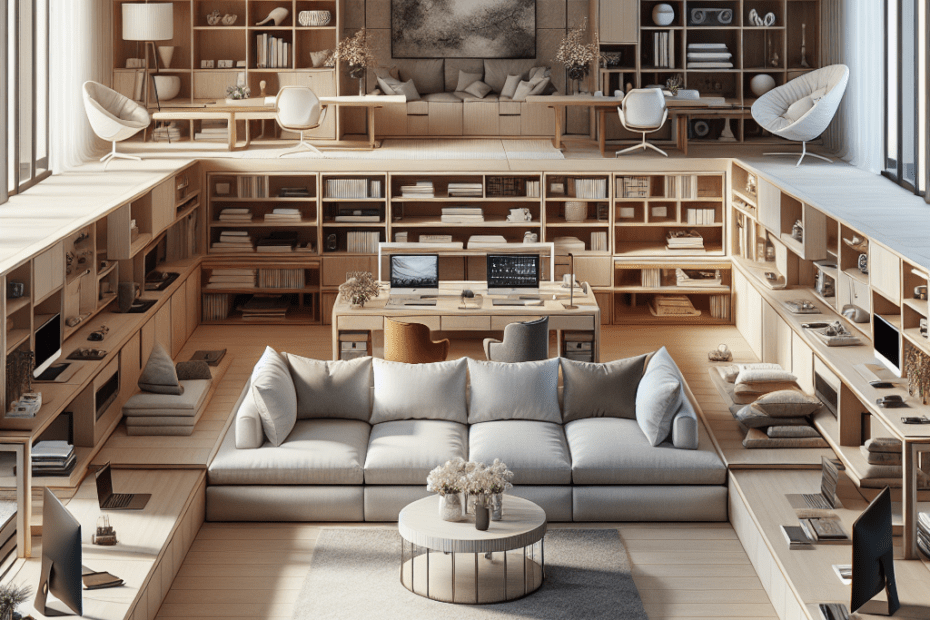Designing a Multi-Functional Living Room
In today’s world, where living spaces are becoming increasingly compact, many people find themselves looking for effective ways to maximize every square inch of their homes. They often explore ways to design spaces that offer both comfort and functionality. A multi-functional living room is an ideal solution for such needs, allowing the space to serve several purposes without compromising on style or convenience.
Understanding Multi-Functional Living Room Design
A multi-functional living room design leverages creativity and strategic planning to create a room that adapts to diverse activities like relaxation, entertainment, work, and even exercise. According to a 2022 Houzz survey, 28% of homeowners stated that they have transformed their living rooms into multi-purpose areas post-pandemic.
Key Tips for Arranging Furniture
Arranging furniture cleverly is crucial in transforming a living room. Follow these key tips to create a cohesive and versatile layout:
- Define Zones: Use area rugs or different lighting arrangements to demarcate different zones such as a reading area, a workspace, or a relaxation corner.
- Choose Versatile Furniture: Opt for furniture pieces that serve multiple purposes, such as a sofa bed or a coffee table with storage.
- Utilize Vertical Space: Add shelves or wall-mounted desks to gain extra storage or workspace without crowding the floor area.
- Consider Foldable Options: Furniture that can be folded away when not in use, such as expandable tables or fold-out desks, can help maximize space.
- Plan the Traffic Flow: Arrange furniture to ensure easy movement across the room, avoiding any clutter or obstruction along main pathways.
Benefits of a Multi-Functional Living Room
The advantages of a multi-functional living room go beyond saving space. When thoughtfully designed, it fosters an adaptable environment that can meet various lifestyle needs. It can be an ideal place for family gatherings, a quiet spot for focused work sessions, or a setting for fun and entertainment.
Case Study: Designing a Multi-Functional Layout
| Room Element | Design Strategy |
|---|---|
| Seating Area | Used sectional sofas that can be rearranged to open up space for guests or family activities. |
| Work Desk | A wall-mounted desk with floating shelves to save floor space, offering a quick conversion from office to living room. |
| Storage | Incorporated ottomans with hidden storage for blankets and board games, reducing visible clutter. |
| Entertainment | Positioned a flat-screen TV on a swivel mount, allowing for multiple viewing angles without the need for extra furniture or stands. |
| Dining | An extendable dining table that doubles as an art or crafting station when needed. |
Key Takeaways
- Multi-functional living rooms can enhance space efficiency and provide adaptable environments for various activities.
- Using versatile and foldable furniture is key to a functional design.
- Proper zoning and traffic flow ensure seamless integration of multiple uses within the same room.
FAQs: Multi-Functional Living Room Design
1. What is a multi-functional living room?
A multi-functional living room is a space designed to fulfill various purposes, such as entertainment, relaxation, work, and exercise, all within the same room.
2. How can I make my living room more versatile?
Utilize smart furniture choices, effective zoning, and creative storage solutions to easily convert your living room into a versatile space.
3. What are some space-saving furniture ideas?
Consider foldable desks, extendable dining tables, storage ottomans, and wall-mounted shelves to optimize space utilization in your living room.
4. How do I define zones in a living room?
Use rugs, lighting, and furniture arrangement to clearly indicate different functional areas like a reading nook or workspace.
5. Why is traffic flow important in multi-functional spaces?
Efficient traffic flow is vital to ensure easy movement across different zones without causing clutter or obstruction, enhancing the room’s functionality and look.
